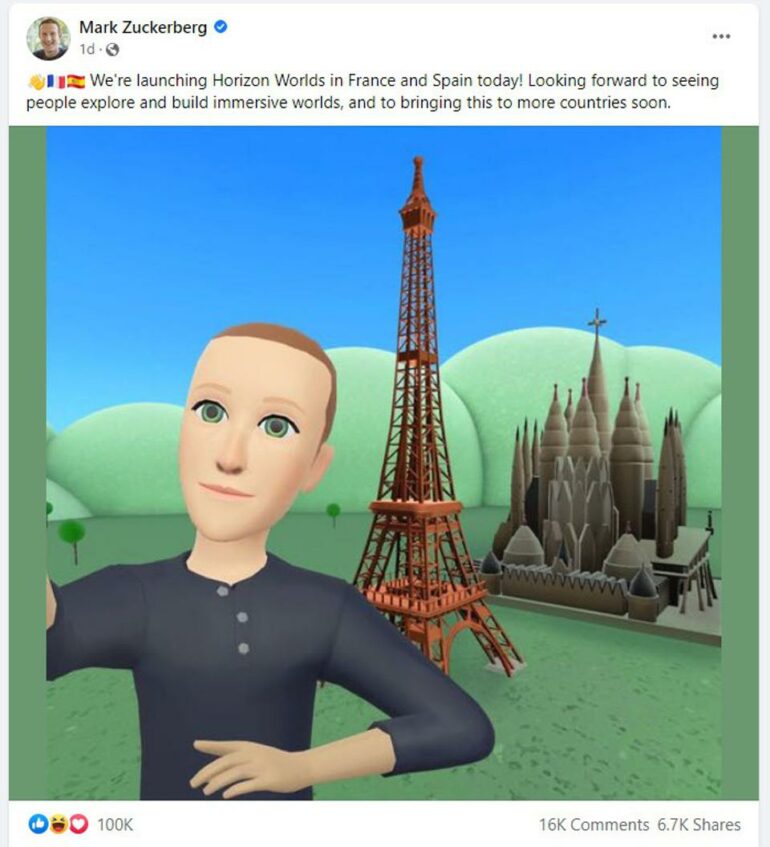Celia Pearce has fond, vivid memories of living a Second Life.
The online non-game virtual world Second Life launched in the early 2000s attracted people, like Pearce, who were looking for, what developer Linden Labs calls a “haven of self-expression.”
Pearce, a professor of game design at Northeastern who has been studying non-game virtual worlds since the mid-1990s, remembers creating her digital avatar, wandering the virtual spaces and homes that others had created and interacting with people who had created entire communities in Second Life.
Twenty years later, Pearce says the Metaverse, Mark Zuckerbergs multi-billion dollar attempt to revolutionize the concept of a virtual world, looks a lot like Second Life–in all the wrong ways.
“One of the things that has really struck me about the Meta Metaverse is that it looks like the virtual worlds of the mid-’90s,” Peare says. “If you can imagine it’s the Renaissance and people are doing cave paintings, that’s what’s going on here. … I find it really astonishing that these people who literally have all the money in the world cannot figure out how to evolve virtual worlds past 1995.”
And Pearce isn’t alone. Since Zuckerberg announced Facebook’s rebrand to Meta and its big bet on the Metaverse last year, Meta’s value has tanked. The company’s stock price dropped more than 70% in less than a year, with shares plummeting 23% after the company missed its earnings targets. After dropping out of the top 20 most valuable U.S. companies, Meta is now worth less than Home Depot.
Instead of rethinking Meta’s future, Zuckerberg has doubled down on the Metaverse: Meta will commit billions more to Reality Labs, the division responsible for Metaverse, adding to the $15 billion already committed to the project.
Shareholders aren’t the only ones concerned. Early glimpses of the Metaverse, including Zuckerberg’s oddly low fidelity avatar, have left the public not only confused about where Meta’s money is going but concerned about the digital future.
Given her experience with non-game virtual worlds, Pearce is similarly perplexed by the Metaverse. She says the glimpses the public have gotten so far are off-putting to both the gaming audience, which has become accustomed to “video games that are indistinguishable from films,” and the broader public.
Metaverse’s failings come down partly to what Pearce sees as Meta’s “lack of awareness to what’s actually going on now and to what happened before” in non-game virtual spaces.
Experiences like Second Life or even Minecraft, online spaces that have managed to attract and maintain audiences over time, succeed by fostering creativity. There’s a reason that, through her research, Pearce found that non-game virtual worlds tended to attract more women and older players, two demographics that are typically underserved in gaming at large.
So far, Zuckerberg has pitched Metaverse as a virtual reality-fueled way of holding work meetings or hanging out with friends, but Pearce says this is more new-fashioned Zoom than revolutionary technology.
“[Meta] really missed the mark in terms of creating something for the right audience,” Pearce says. “They’ve also missed the mark in terms of understanding where the industry is, both in terms of what people expect visually from games and what people are actually doing in non-game experiences, which is making stuff. Creativity is the killer app in virtual worlds.”
Yakov Bart, associate professor of marketing, and Joseph G. Riesman, research professor, say Meta has also failed to sell customers on the idea of the Metaverse. There’s an inherent challenge here, Bart admits. Unlike when Apple launched the iPhone, the Metaverse is not a physical product. It’s an abstract concept, one that Meta might not even fully comprehend.
“It’s very hard to explain something to people when you don’t have a clear idea on what exactly you’re trying to deliver,” Bart says.
Companies and marketers find success by trying to figure out what customers want and then delivering products, services or experiences that fill that need or desire, whether it’s an incremental upgrade, like a new iPhone, or a totally new product. In the case of the Metaverse, it’s neither, Pearce and Bart say.
The concept of a metaverse can be traced back to Neil Stephenson’s 1992 techno-dystopian novel “Snow Crash,” and platforms like Second Life have been trying to bring that idea to life since the 2000s and earlier. It’s not a new concept, and the simultaneous complexity and vagueness of the Metaverse could be the downfall of this Metaverse, Bart says.
In the 1990s, Motorola launched the Iridium satellite constellation, a set of global satellites that it hoped would revolutionize wireless communications. Unfortunately for Motorola, cell towers proved to be a much less expensive and complex solution to the same problem, one that was “good enough” for people even though it might not have been as good of a product. Bart can see a similar situation happening with the Metaverse.
“This big vision that Mark has may be a bit too much for too much money based on what consumers really need when they look for entertainment and communication with each other in virtual and mixed reality worlds,” Bart says.
Despite her cynicism about Meta’s big budget experiment in virtual worldbuilding, Pearce says the idea at the core of the Metaverse is still an appealing one. For the digital denizens of Second Life, it wasnt just a program they logged into. It was a digital portal to an entire world and community, an opportunity to connect with others and create something special.
“It’s just flabbergasting to me that people with so many resources can so spectacularly mess things up when the opportunity to do something cool is there,” Pearce says.
Provided by
Northeastern University
Citation:
Why is Mark Zuckerberg’s Metaverse failing? (2022, November 4)

